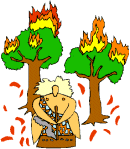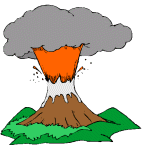

Natural Air Pollution

Whilst man-made pollution and poor air quality is major environmental concern, there are many natural sources of pollution which are often much greater than their man-made counterparts.
Natural sources of sulphur dioxide include release from volcanoes, biological decay and forest fires. Actual amounts released from natural sources in the world are difficult to quantify. In 1983 the United Nations Environment Programme estimated a figure of between 80 million and 288 million tonnes of sulphur oxides per year (compared to around 69 million tonnes from human sources world-wide).

Natural sources of nitrogen oxides include volcanoes, oceans, biological decay and lightning strikes. Estimates range between 20 million and 90 million tonnes per year nitrogen oxides released from natural sources (compared to around 24 million tonnes from human sources worldwide).
Ozone is a secondary photochemical pollutant formed near ground level as a result of chemical reactions taking place in sunlight. About 10 to 15% of low level ozone, however, is transported from the upper atmosphere (called the stratosphere), where it is formed by the action of ultraviolet (UV) radiation on oxygen (the ozone layer).
Natural sources of particulate matter are less important than man-made sources. These include volcanoes and dust storms. However, such sources do account for intense high particulate pollution episodes, occurring over relatively short times scales. It is not unknown for Saharan dust to be deposited in the UK after being blown thousands of miles.
Volatile organic compounds (VOCs) are naturally produced by plants and trees. Isoprene is a common VOC emitted by vegetation, and some believe it to be a more significant trigger for asthma an other allergic reactions than man-made irritants. Plant, grass and trees are also a source of pollen, which can act as triggers in some asthmatics. Pollen is in the air year-round, but the concentration is highest during the growing season, from March to the first frosts in autumn.
Natural pollutants found indoors include the dustmite, mould spores and radon gas.
 | Lightning |
Websites
Other topics
• US Volcanic Hazards
• TOMS
• Natural Hazards/Pollution
• Fire-Related Pollution
• Consequences
• Introduction
• Asthma
• Carbon Monoxide
• Cars
• CATs
• Chemistry
• Cities
• Clean Air Acts
• Cleaner Fuels
• Countryside
• Dispersion
• Doing Our Bit
• Dustmite
• Emissions
• Fossil Fuels
• History
• Human Health
• Impacts
• Indoors
• Industry & Power
• Legislation
• Lichens
• London Smog
• Management
• Measuring
• Megacities
• Modelling
• Monitoring
• Mould Spores
• Natural Sources
• Nitrogen Dioxide
• Outdoors
• Ozone
• Particulates
• Pollutants
• Radon
• Smog
• Smoke
• Smoking
• Standards
• Sulphur Dioxide
• UK Air Pollution
• UK Strategy
• Vehicle Controls
• VOCs
• Wildlife
 Print Topic
Print Topic